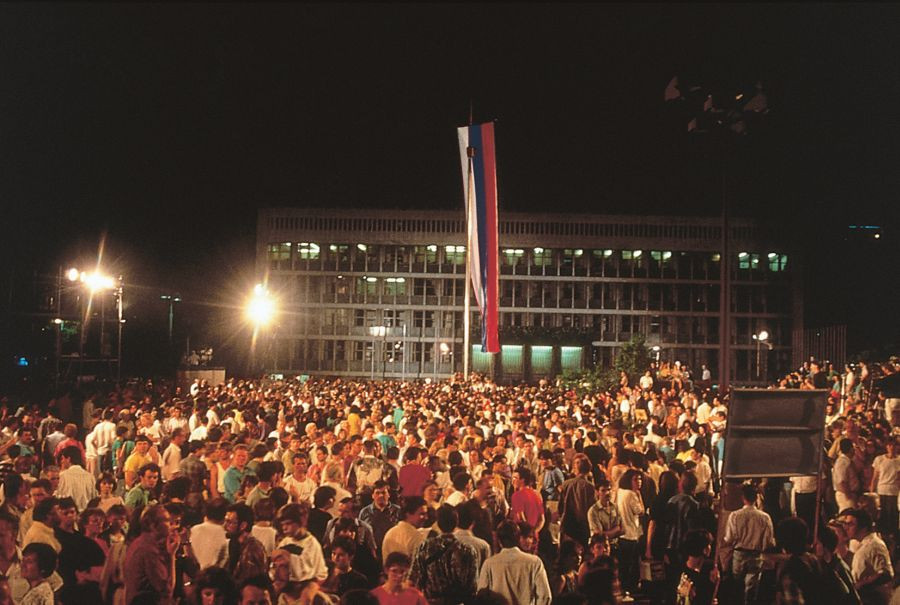Important dates for Slovenia
1 January–30 June 2008: Slovenian Presidency of the Council of the EU.
1 January 2007: Slovenia introduces the euro.
1 May 2004: Slovenia becomes a member of the EU.
29 March 2004: Slovenia becomes a member of NATO.
1 February 1999: The association agreement with the EU enters into force.
22 May 1992: Slovenia becomes a permanent member of the UN.
15 January 1992: The EU officially recognises Slovenia.
25 June 1991: Declaration of the independent Republic of Slovenia.
23 December 1991: Adoption of the new Slovenian Constitution.
1990: Plebiscite on independence.
1945: The formation of the Federal People's Republic of Yugoslavia, with the People's Republic of Slovenia as one of its six federal entities.
1941–1945: The dismemberment of Yugoslavia by the Axis Powers.
1918: The defeat of the Austro-Hungarian Empire; the creation of the state of Slovenes, Croats and Serbs; the Kingdom of Serbs, Croats and Slovenes, renamed the Kingdom of Yugoslavia in 1929.
1848: Unified Slovenia, the first Slovenian political programme.
1809–1813: Napoleonic occupation – the Illyrian Provinces.
18th century: The Enlightenment and compulsory universal education.
1550: Protestantism; the first book in the Slovenian language.
15th to 17th centuries: Peasant revolts.
15th century: Turkish invasions begin.
14th to 15th centuries: Most of the territory of Slovenia, including all its hereditary estates, is taken over by the Habsburgs; in 1456, the Counts of Celje, the last feudal dynasty in Slovenia, die out.
11th to 14th centuries: The development of medieval towns in Slovenia.
11th century: The regions of Carniola, Styria, Carinthia and Gorizia begin to develop; intensive German colonisation.
10th century: The appearance of the Freising Manuscripts, the earliest known text written in Slovenian.
9th century: The spread of the Frankish feudal system; the Slovenian nation begins to form.
8th century: The beginnings of the conversion to Christianity.
7th to 11th century: The State of Carantania, the oldest known independent
Slavonic tribal union in this region.
After 568: Dominance of Slavic people on the territory of Slovenia.
5th and 6th century CE: Invasions by the Huns and Germanic tribes.
Around 10 BCE: The Roman Empire; the appearance of the first towns.
4th and 3rd century BCE: The arrival of Celts; the Noricum Kingdom.
120,000 to 1,300 BCE: Remains from the early Stone Age – the Palaeolithic; among them the oldest musical instrument in the world; evidence of hunting and Urnfield culture.
250,000 BCE: The first evidence of human habitation on the territory of present-day Slovenia (two tools made of stone from Jama Cave in the Loza Woods near Orehek).
Similar articles
-
Prime Minister Janez Janša: "It is in the nature of man to dream, and in the nature of a free man to have the means to make those dreams come true."
-
Alfred Brežnik: Slovenia exceeded all expectations and has become a commendable and successful country, an example worthy of imitation
-
Slovenian athletes successfully represent Slovenia at the Tokyo Olympics
-
Video
David Sipoš: Those who persist and believe in what they do, those will win and succeed on their path
-
Plečnik's works added to the UNESCO World Heritage List
-
30 years of sporting achievements
-
Triumphant Year of 1991
-
Prime Minister Janez Janša at the ceremony marking the 30th anniversary of the battle of Trzin with the unveiling of a memorial to Edvard Peperko
-
Prime Minister Janez Janša: The Slovenian World Congress is a strong link between Slovenians abroad and their homeland
-
Prime Minister Janez Janša at the ceremony marking the 30th anniversary of Slovenia's independence organised by the Slovenia in the World expatriate association


